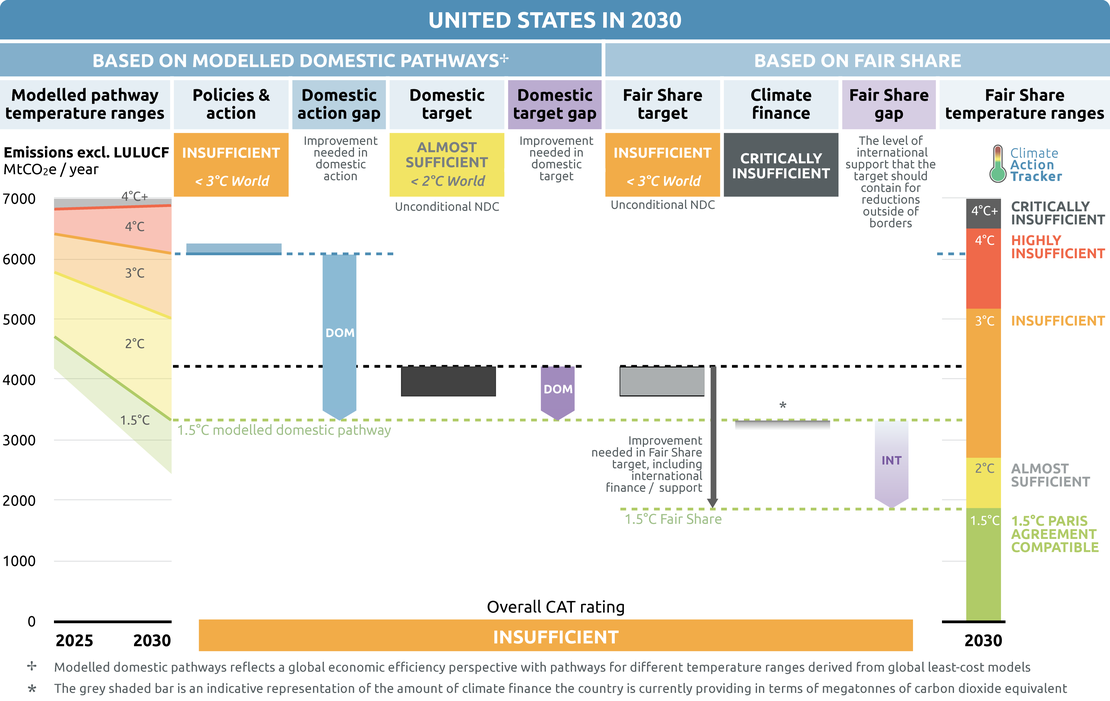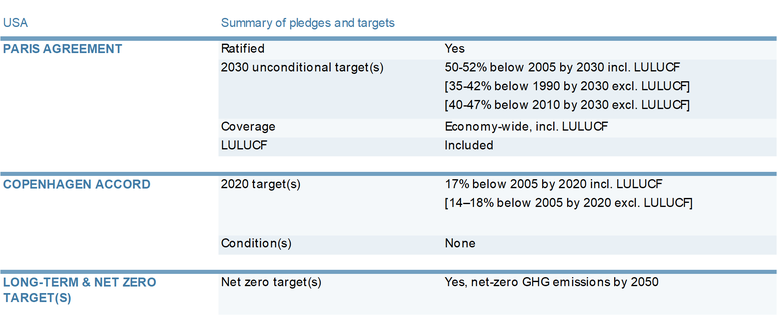Targets
Paris Agreement targets
NDC description
President Biden moved to re-join the Paris Agreement on his first day in office. In line with its re-joining, on 22 April 2021 the US submitted a strengthened Paris Agreement target - a Nationally Determined Contribution (NDC) – of reducing emissions by 50%–52% below 2005 levels by 2030, including land-use, land-use change and forestry (LULUCF).
The CAT estimates that the 50%–52% reduction target in emissions including LULUCF would translate to a range of 3,715 ̶ 4,219 MtCO2e absolute GHG emissions in 2030 excluding LULUCF (or 43%–50% below 2005 levels), depending on whether the sink from LULUCF is at the high or low end of the projections (US Government, 2021).
The new NDC target represents major progress beyond the previous US target of 26%–28% below 2005 levels by 2025 (Obama-era) but is not quite enough to bring US domestic emissions in line with what would be needed to achieve the Paris Agreement’s 1.5°C limit.
A CAT analysis indicates that the US should aim to reduce its national emissions by at least 57-63% below 2005 levels by 2030 (incl. LULUCF) and provide support to other countries in order to be consistent with the Paris Agreement 1.5°C limit and put the country on track to achieve President Biden’s stated 2050 net zero target (Climate Action Tracker, 2021d). The new US target represents the single biggest reduction in the global emissions gap of 23-27 GtCO2e in 2030 by 5%–10% (Climate Action Tracker, 2021a).
The CAT rates the US domestic target as “Almost sufficient” and its fair share target as “Insufficient”. For the US, a stronger emissions reduction target is needed to be consistent with a 1.5°C pathway (assuming the US would in addition provide support to developing countries to reduce emissions) and would put the country on a better track to achieving its 2050 net zero emissions target.
We rate the target of reducing emissions by 50%–52% (or 43%–50% excluding emissions from land-use, land-use change and forestry) below 2005 levels by 2030 as “Almost sufficient” when compared to modelled domestic emissions pathways. The “Almost sufficient” rating indicates that the US proposed domestic target in 2030 is not yet consistent with the Paris Agreement’s 1.5°C temperature limit but could be, with moderate improvements. If all countries were to follow the US approach, warming could be held at—but not well below—2°C. Although the proposed target represents a significant improvement compared to its first NDC, the new US target is not stringent enough to limit warming to 1.5°C, and needs further improvements.
We rate the target of reducing emissions by 50%–52% (or 43%–50% excluding emissions from land-use, land-use change and forestry) below 2005 levels by 2030 as “Insufficient” when compared with its fair-share emissions allocation. The “Insufficient” rating indicates that the US fair share target in 2030 needs substantial improvements to be consistent with the Paris Agreement’s 1.5°C temperature limit. Some of these improvements should be made to the domestic emissions target itself, others could come in the form of additional financial support for emissions reductions achieved in developing countries. If all countries were to follow the US approach, warming would reach up to 3°C.
The US’s international climate finance is rated “Critically insufficient” (see below) and is not enough to improve the US’s fair share rating.

We rate the US international public climate finance contributions as “Critically insufficient.” The US has committed to increase its climate finance but contributions to date have been very low compared to its fair share. To improve its rating, the US needs to ramp up the level of its international climate finance contributions in the period post-2020 and accelerate the phase-out of all fossil finance abroad (not only coal).
A high share of the US contributions has climate as a main component and is largely based on grants, which are more concessional than loans. The US climate finance contributions also exhibit, on average, a declining trend over recent years – up to 2019 (OECD, 2018). A clear and sustained increase in international finance contributions is fundamental in the period post-2020.
In April 2021, President Biden committed in an executive order to double annual public climate finance overseas compared to the average level during the second half of the Obama Administration by 2024. The executive order provides the US government with a strategic vision on international climate finance with a 2025 horizon and reaffirms the US commitment to the continuous support towards the USD 100 billion goal per year through 2025 (The White House, 2021d).
The USD 100bn goal is insufficient post-2020. This level of finance, if achieved by a sustained upwards trend in annual contributions, would improve the CAT finance rating. After the June 2021 G7 Summit, President Biden committed up to USD 2bn climate finance “to support developing countries as they transition away from unabated coal-fired power” (Piper, 2021). No clarification on how this amount relates to previous announcements was provided.
In early 2021 the US announced its intention to end overseas funding of “high emitting” fossil fuel projects (Rowling, 2021), but without specifying what is considered ‘high emitting’. No plans beyond this initial announcement have yet been legislated. President Biden vowed to scale back and end public investments in carbon-intensive fossil fuel-based energy overseas, although did not provide a date nor further details (The White House, 2021d). The G7 countries committed to end “new direct government support for unabated international thermal coal power generation by the end of 2021” (G7 United Kingdom, 2021). However, there is currently no evidence that US support has stopped for on-going fossil fuel projects abroad, such as the Jawa 9-10 Suralaya Coal Plant in Banten in Indonesia and the Long Phu 1 Coal Plant in Vietnam (EndCoal, 2020).
The recent announcements made by the Biden administration are a good sign that the US trend in climate finance is changing, but the Administration has yet to act on those announcements. The critically insufficient rating reflects past action, and the US can improve its rating if the new administration follows through and improves its announcements.
Further information on how the CAT rates countries (against modelled domestic pathways and fair share) can be found here.
Last NDC update
The US updated its target to the Paris Agreement, submitted on Earth Day (22 of April 2021), committing to a reduction in economy-wide emissions to 50-52% below 2005 levels by 2030. This target represents a significant improvement in terms of climate mitigation ambition and would reduce the global emissions gap by 5%-10% in 2030, the largest additional national reduction proposed in the 2020/2021 round of climate target updates as of June 2021.
While considerably stronger than the previous US Paris Agreement target (26-28% below 2005 levels by 2025) this new US goal is still about 5-10 per cent points short of a 1.5˚C compatible 2030 target, which would have been 0.4-0.9 GtCO2e/year lower. The NDC sets an unconditional economy-wide emissions reduction target covering all greenhouse gases. The submission also outlines a high-level sector-by-sector plan to achieve the emissions reduction target, including the goal of a carbon-free power sector by 2035. For the full analysis of the US NDC click here.

Net zero and other long-term target(s)
The Biden administration submitted an update long-term strategy to the UNFCCC in November 2021 (U.S. Department of State, 2021), officially committing the USA to net zero emissions by 2050 latest. The net zero target covers all greenhouse gas (GHG) emissions, makes transparent assumptions on CO2 removal by nature-based and technology-based solutions, and specifies several key components for comprehensive planning.
The US government has several avenues to improve the scope, target architecture and transparency of its net zero target. The US government could include international aviation and shipping to its target coverage, and explicitly commit to reach net zero emissions within its own borders without any use of international offsets. Furthermore, the target itself could be enshrined in law in combination with adopting a legally-binding review, revision, and reporting mechanism. The US government further ought to explain why its net zero target is a fair contribution to the global goal of limiting warming to 1.5˚C above pre-industrial levels, and transparently address any existing gap between its net zero target and what would be a fair target.
For our full USA net zero analysis click here.
2020 pledge
The United States is not a Party to the Kyoto Protocol. While a target of a 7% reduction below 1990 levels from 2008–2012 was originally negotiated and agreed, the US never ratified the Protocol and therefore, the target never came into force.
Under the Copenhagen Accord, the US announced an emissions reduction target of 17% below 2005 levels by 2020 (U.S. Department of State, 2010), which would be around 14%–18% below 2005 levels (excl. LULUCF). The CAT estimates that total emission will decrease by 19%–20% in 2020 below 2005 (excl. LULUCF), as a result of the economic slowdown and other effects of the pandemic, and it will overachieve the 2020 target.
Summary table
Further analysis
Latest publications
Stay informed
Subscribe to our newsletter






